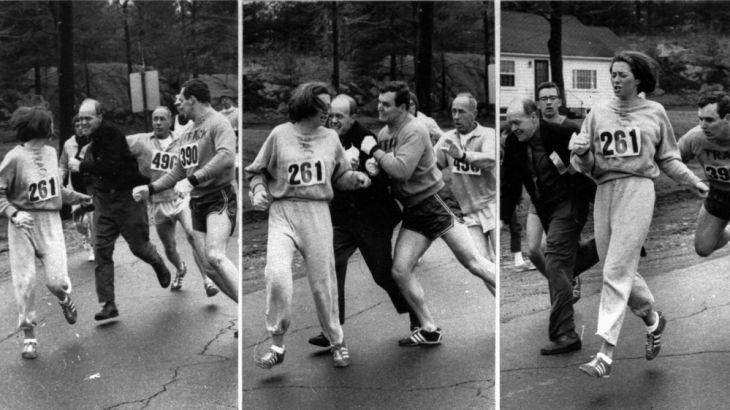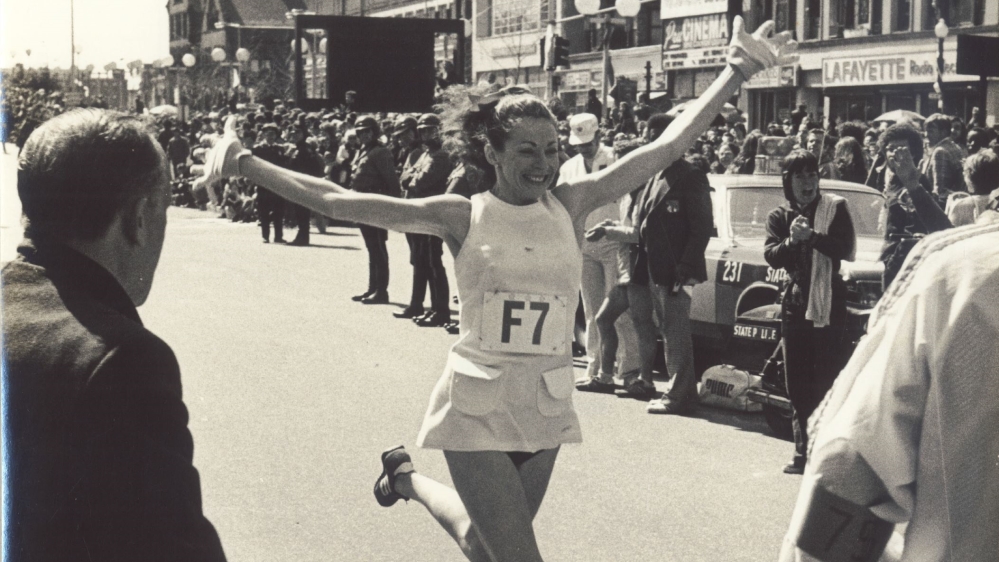Kathrine Switzer to run Boston Marathon again, 50 years on
When Kathrine Switzer entered the Boston Marathon in 1967, a race official tried to drag her off the course.

For most people, the idea of running a marathon would be tough enough.
But imagine running it as a pariah, with most of those watching either expecting or willing you to quit and one of the race officials even trying to physically drag you out of the race.
Keep reading
list of 4 itemsTen years after Chibok girls kidnapping: One woman’s struggle to move on
Poland lawmakers take steps towards liberalising abortion laws
Polish lawmakers debate reforming strict abortion laws
That’s exactly what happened when Kathrine Switzer became the first woman to enter the Boston Marathon in 1967.
On Monday, Switzer will run the same race again at the age of 70.
She is among 32,000 runners expected to take part – nearly half of them women.
In between training near her home in New Paltz, New York, Switzer squeezed Al Jazeera into the marathon round of interviews she’s undertaking as interest in her remarkable story is rekindled 50 years on.
Back then, although there was no specific rule banning women from the marathon, it was definitely frowned upon. She entered the race by using her first initials only in the entry form (she was a fan of author JD Salinger, she says).
She breaks into a warm smile as talks me through the photographs of the infamous moment when race official, Jock Semple, attempted to stop her from running,
“I turned and I saw this fierce face, the fiercest face I’d ever seen. He grabbed me and screamed, ‘get the hell out of my race’ and tried to rip off my bib number. It happened in a flash, but it was a flash that changed my life.”
Despite being shook up, Switzer did finish the race and became a hero and activist for women’s long-distance running, not only changing her life, but helping to completely change attitudes in the process.
IN PICTURES: Runners flock to Tehran’s first marathon
“Back then, women who did anything arduous were either masculine or endangering themselves. There were even whispers that you would turn into a man or your uterus would fall out,” Switzer said.
What’s more, the resistance she faced wasn’t just from men.
“Many women were even more hesitant. They were fearful of what I was becoming and angry that I was out trying.”
Switzer’s efforts not only culminated in the Boston Marathon finally openly accepting women entrants in 1972, but also the women’s marathon being admitted as an Olympic event in 1984. Before that the longest women’s Olympic race was the 1,500 metres.
“In the last 50 years, we’ve seen nothing short of a social revolution in women’s running and I say revolution because in the United States now there are more women runners than men. Fifty-eight percent of all the runners are women. The trend is also the same in Canada, France and Japan. That’s happened in my lifetime.”
![Switzer's boyfriend shoved the official who tried to stop her from running to the ground [Boston Herald]](/wp-content/uploads/2017/04/18edcb38ed624d4e8096ac5aa7e86dbc_18.jpeg)
But Switzer’s work is far from over. In the last couple of years she’s started the 261 Fearless charity; a women’s running organisation named after the bib number she wore back in 1967.
“How 261 happened was really amazing,” she tells me. “People were sending pics of themselves with this [bib] number on their back even though they had own number and saying it made them feel fearless. They were sending me pictures of their 261 tattoos. It really means something to them. So we thought we’d take this feeling out to those women who are marginalised and I’m sorry to say that most of the women in the world still live in a fearful situation.”
Now there are dozens of 261 Fearless running clubs around the world and the Boston Athletic Association has given more than a hundred places in Monday’s marathon to women running under the group’s name, in honour of the 50th anniversary of Switzer’s achievement.
But what of Switzer’s own renewed running career?
After competing in the 1976 Boston Marathon, Switzer decided to concentrate on her in activism and television commentary.
“But then at the age of 60, I suddenly realised there were women who were older than me, running in events that I had helped create, but never ran myself. So I got a little jealous.”
She began running again at the age of 62 and now in her seventies, she has no plans to give up.
“I want to run the New York Marathon. I won it in 1974, but that was when it was four laps of Central Park. I want to run it in the streets. The same with London.”
But as for Monday: “This race is not about time, it’s about celebration and completion … But after that, I want to push for better performances.”
 |
| After her first marathon, Switzer became an advocate for women’s long-distance running [Jeff Johnson] |